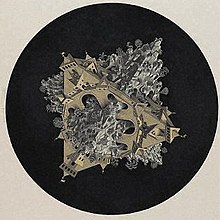Double Planetoid is a wood engraving print by the Dutch artist M. C. Escher, first printed in 1949.

Description
editDouble Planetoid is printed in four colors from four wood blocks.[1] It depicts a planetoid in the shape of a compound of two tetrahedra, interpenetrating each other to form a stellated octahedron.[2] One of the two tetrahedra is entirely covered by architecture, while the other is a wilderness populated by saurian creatures.[1] The planetoid is shown within a circular black field, 37.5 centimetres (14.8 in) in diameter.[3]
Themes
editDouble Planetoid is part of a series of Escher's prints from the 1940s and 1950s that depict small polyhedral planets, also including Gravitation (1952) and Tetrahedral Planetoid (1954),[4] and possibly in the same universe as his print Stars (1948).[1] It has thematic connections with other Escher prints from the same period that provide simultaneous views of intermingled worlds, including the more realistic prints Puddle (1952) and Three Worlds (1955),[5] and is one of many Escher works using the geometry of polyhedra and polyhedral compounds.[6]
Collections
editCopies of the print are included in the permanent collections of the National Gallery of Canada,[7] the US National Gallery of Art,[8] and the Museum of Fine Arts, Boston.[3]
See also
edit- Tetrahedral hypothesis, the discredited scientific theory that the arrangement of the Earth's continents comes from the geometry of a tetrahedron
References
edit- ^ a b c Double Planetoid, Escher in the Palace, 2 December 2017, retrieved 2021-11-14
- ^ Coxeter, H. S. M. (1985), "A special book review: M. C. Escher: His life and complete graphic work", The Mathematical Intelligencer, 7 (1): 59–69, doi:10.1007/BF03023010, S2CID 189887063. See in particular p. 61.
- ^ a b "Double Planetoid, Maurits Cornelis Escher (Dutch, 1898–1972), 1949", Collections, Museum of Fine Arts, Boston, retrieved 2021-11-14
- ^ Gravity, 1952, Escher in the Palace, 29 June 2018, retrieved 2021-11-14
- ^ Hofstadter, Douglas R. (2003), "Mystery, classicism, elegance: an endless chase after magic", in Schattschneider, Doris; Emmer, Michele (eds.), M.C. Escher's Legacy: A Centennial Celebration, Berlin & Heidelberg: Springer, pp. 24–51, doi:10.1007/3-540-28849-x_4
- ^ Messina, Barbara; Chiarenza, Stefano (December 2020), "Drawing and geometric constructions of polyhedra in the art of Escher", in Cheng, Liang-Yee (ed.), ICGG 2020 - Proceedings of the 19th International Conference on Geometry and Graphics, Advances in Intelligent Systems and Computing, vol. 1296, Springer International Publishing, pp. 895–903, doi:10.1007/978-3-030-63403-2_81
- ^ "M. C. Escher: Double Planetoid, December 1949", Collection, National Gallery of Canada, retrieved 2021-11-14
- ^ "M. C. Escher: Double Planetoid, 1949", Collection, National Gallery of Art, retrieved 2021-11-14